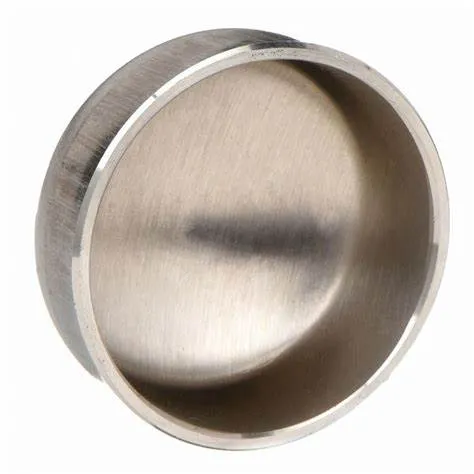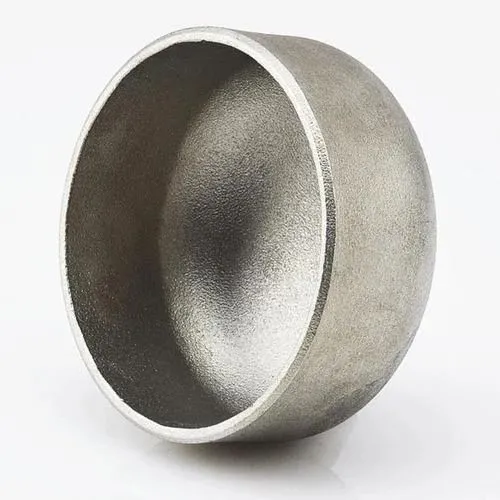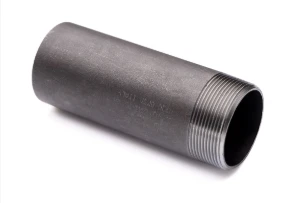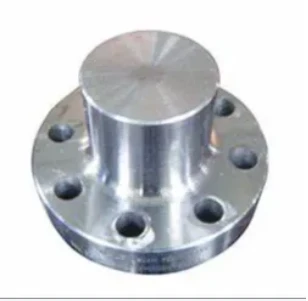JIS B2311 Standardek Pîşesaziya Japonî ye ku pêlavên lûleya welding-ê vedigire, di nav de kelûpelên ku di pergalên boriyê de têne bikar anîn. Kûçikên welding bi armanca girtina dawiya boriyekê xizmetê dikin, ji bo pêşîlêgirtina rijandin an pîsbûnê, mohrkirinê peyda dikin. Li vir danasînek ji JIS B2311 kepçeyên welding-ê ye:
- 1. JIS B2311 Standard:
- - Standarda JIS B2311 hewcedariyên ji bo sêwirandin, pîvan, materyal, çêkirin û ceribandina pêlavên welding, di nav pergalên lûleyê de, di nav de, diyar dike.
- - Standard piştrast dike ku kelûpelên ku li gorî standardên JIS têne hilberandin standardên kalîteyê digirin û bi pêkhateyên din ên boriyê re hevaheng in.
- 2. Kîp-Welding Cap:
- - Li gorî JIS B2311 kepçeyek weldingê, pêçekek e ku ji bo vegirtin û girtina dawiya boriyek bi ewle hatî çêkirin, parastin û yekparçebûna pergala boriyê diparêze.
- - Keps di rewşên ku dawiya boriyê pêdivî bi girtina domdar an demkî hewce dike de têne bikar anîn da ku pêşî li lehî, gemarî bigire, an jî ji bo qedandina pergalê peyda bike.
- 3. Materyal û Avakirin:
- - Kûçikên welding di bin taybetmendiyên JIS B2311 de di materyalên cihêreng ên wekî pola karbonê, pola zengarnegir, û pola alloy de peyda dibin da ku daxwazên cûda yên serîlêdanê bicîh bînin.
- - Van kapanan bi karanîna rêbazên avahîsaziyê yên standard têne çêkirin ku dema ku heya dawiya boriyekê têne weld kirin pêwendiyek bihêz û bê rijandin.
- 4. Serlêdan û Feydeyên:
- - Kûçikên welding di pîşesaziyên cihêreng de, di nav de neft û gaz, pêvajoyên kîmyewî, nebatên paqijkirina avê, û hêj bêtir li cihê ku pêdivî ye ku dawiya boriyan bi ewlehî were girtin, sepanan dibîne.
- - Kapan parastina dawiya boriyan ji hêmanên hawîrdorê peyda dike, pêşî li gemariyê digire, û dibe alîkar ku paqijî û yekbûna pergala boriyê biparêze.
- 5. Sazkirin û Welding:
- - Pratîkên sazkirinê yên birêkûpêk, di nav de lihevkirina rast, amadekirina dawiya boriyê, û teknîkên weldingê, di dema sazkirina kelûpelên welding-ê de girîng in da ku mohrkirinek hişk û gemarî peyda bikin.
- - Welding rêbazek hevpar e ji bo girêdana kelûpelan bi lûleyan, peydakirina girtina ewledar û domdar ku dikare li ber zext, guherînên germahiyê, û herikîna şilavê di hundurê pergalê de bisekinin.
- Bi kurtahî, JIS B2311 kepçeyên welding-ê hêmanên girîng in ku di pergalên boriyê de têne bikar anîn da ku dawiya lûleyan bi ewlehî veqetînin û biparêzin. Van kapan bi daxwazên standardkirî re tevdigerin da ku kalîte, pêbawerî, û lihevhatî di nav sepanên pîşesaziyê de ku girtina boriyê û parastin hewce ne.
What Is a Butt Welding Cap and How Is It Used in Industrial Piping?
In industrial piping systems, end-of-line sealing and branch closures require robust solutions. A butt welding cap serves as a critical component for terminating pipes securely. By providing a seamless, welded closure, this fitting maintains system integrity, prevents leaks, and supports compliance with industry standards.
What Is a Butt Welding Cap?
A butt welding cap—also called a pipe end cap or buttweld end cap—is a round fitting designed to close off the end of a pipe. It’s manufactured to match the pipe’s outer diameter and schedule, with either a hemispherical or flat face. To install, both the pipe end and cap are beveled to form a V‑groove, enabling full‑penetration, fusion welds. Common materials include carbon steel, stainless steel, nickel alloys, and other engineered grades, chosen to satisfy pressure, temperature, and corrosion‑resistance requirements.
How Is Butt Welding Cap Used in Industrial Piping?
Butt welding caps find application across oil & gas, petrochemical, power generation, water treatment, and general process industries for both permanent and temporary closures. During hydrostatic testing, technicians install caps to seal off sections of piping while monitoring for leaks. In new construction or retrofit projects, caps terminate branch lines, future tie‑in spools, or dead‑end mains until system expansion. Welders prepare each joint by cleaning and beveling surfaces, aligning the cap precisely, and executing a root pass followed by filler passes per the qualified Welding Procedure Specification (WPS). Post‑weld heat treatment and non‑destructive examination (NDE)—such as radiography or ultrasonic testing—verify weld integrity and compliance with ASME B16.9 and related standards. Additionally, temporary caps enable safe isolation during maintenance, allowing for segment testing and dewatering under regulatory protocols.
Benefits and Best Practices
Butt welding caps offer a smooth‑bore transition that minimizes flow disruption and stress concentration. Their full‑penetration welds deliver exceptional structural strength and leak resistance. To optimize performance, engineers should:
Select caps with matching material grades and wall thicknesses
Adhere to proper bevel angles and joint fit‑up tolerances
Follow qualified WPS protocols rigorously
Consider cladding or protective coatings in corrosive environments to extend service life
Regular inspection and thorough documentation ensure long‑term reliability and safe operation under demanding conditions.
Butt welding caps are indispensable components for achieving durable, leak‑proof pipe terminations in a wide range of industrial applications.
Butt Welding Cap FAQs
What is a butt welding cap?
|
What materials are commonly used?
|
What standards govern butt welding caps?
|
How are butt welding caps installed?
|
Where are butt welding caps typically used?
|
What are the advantages of threaded caps?
|
















